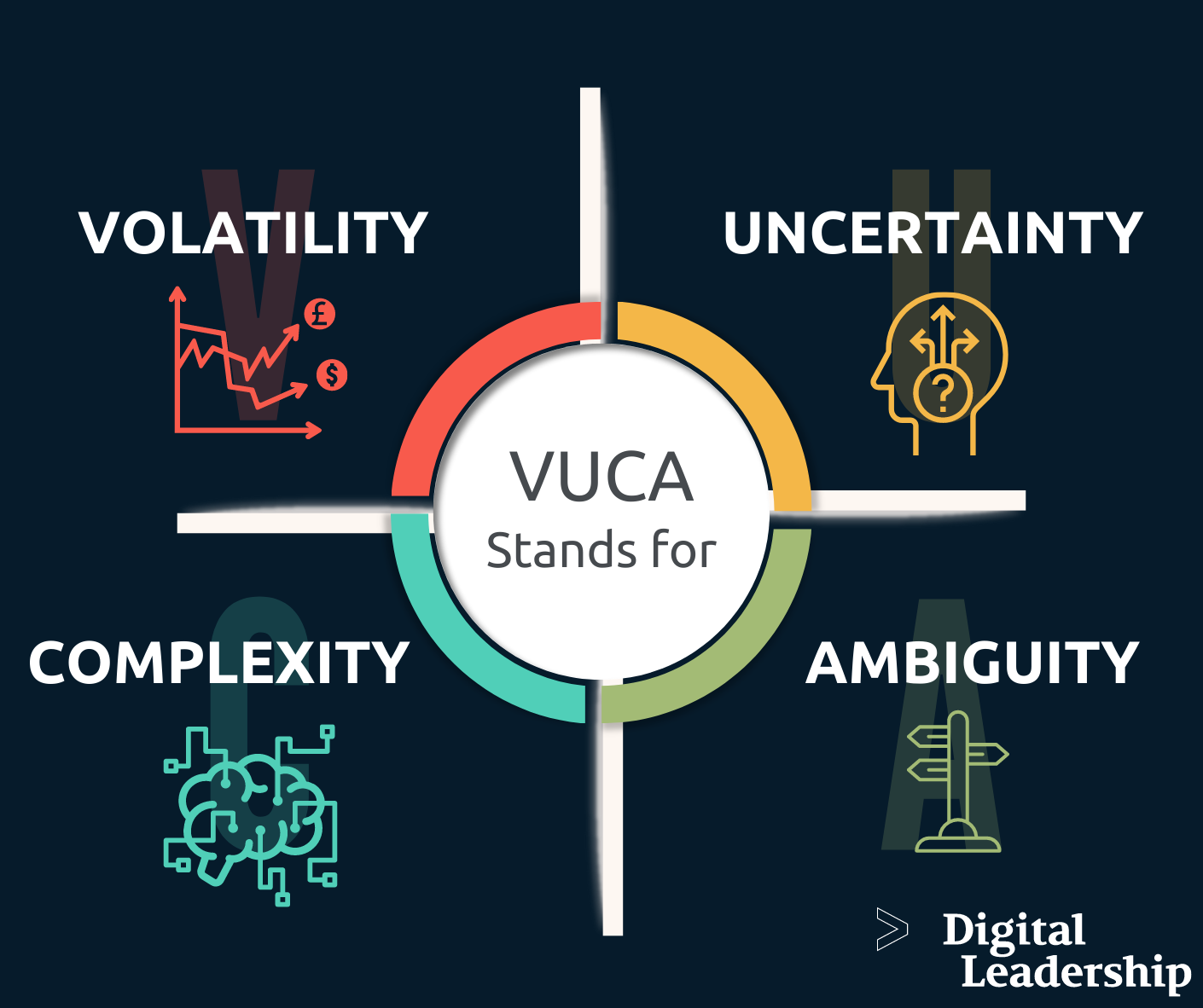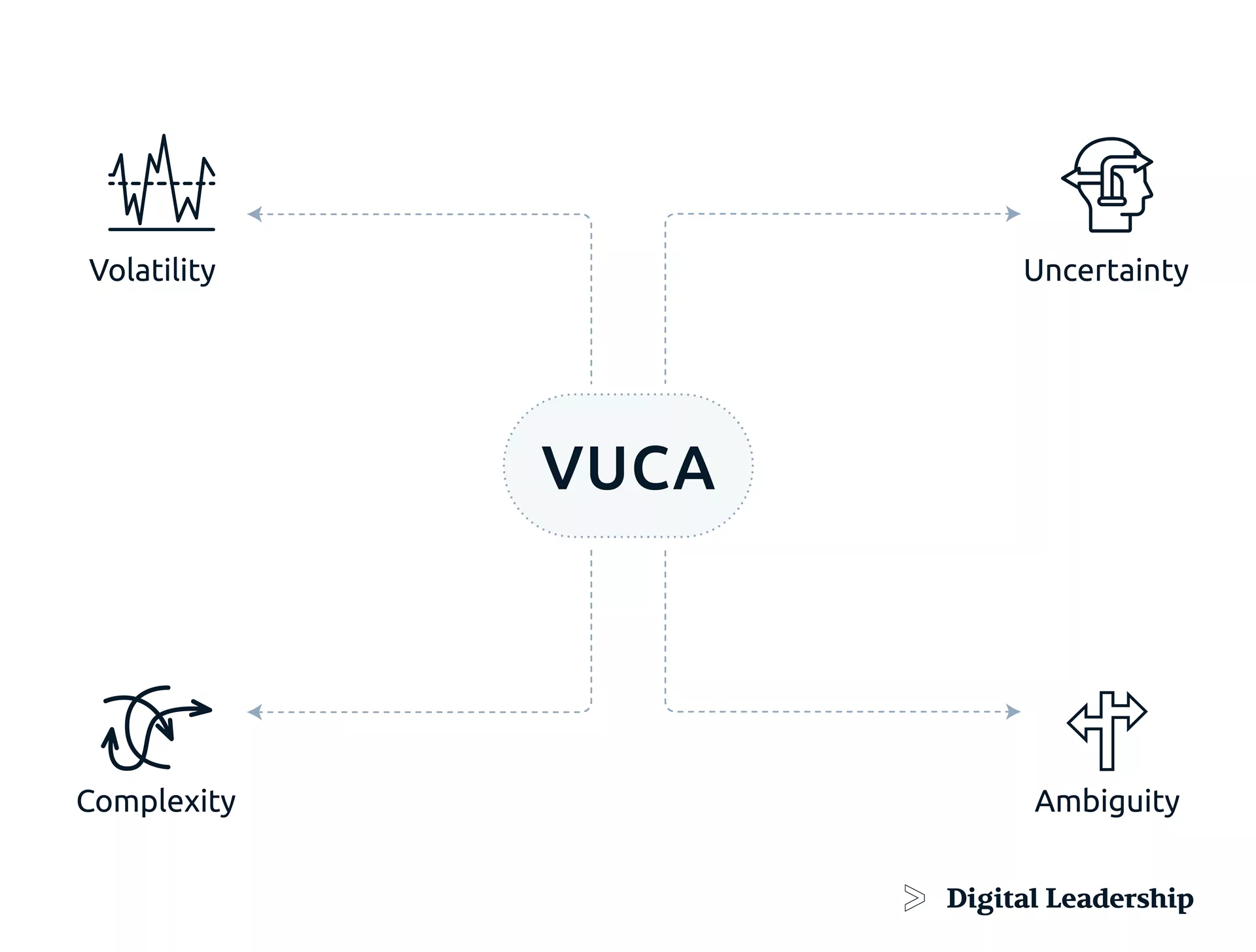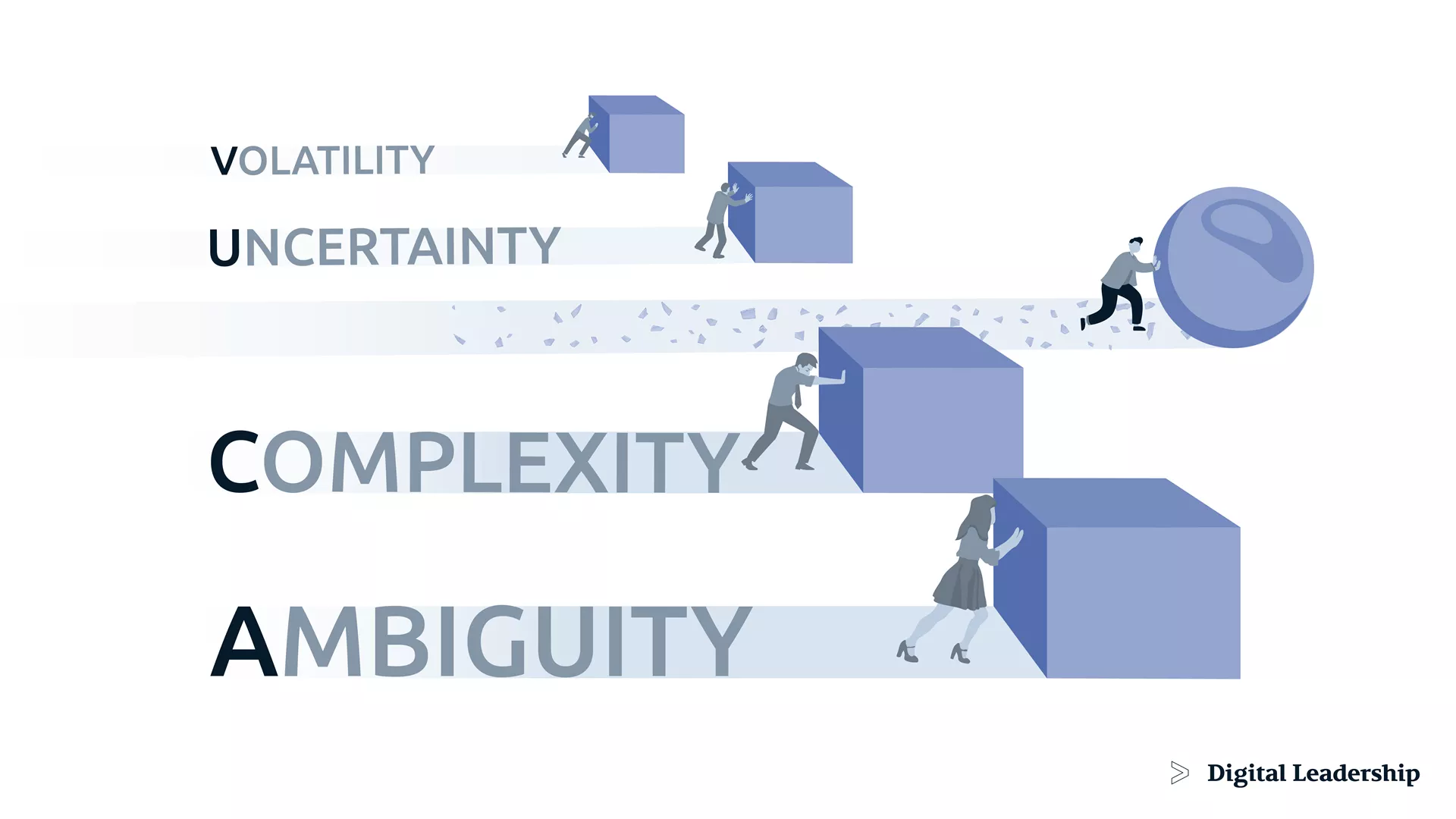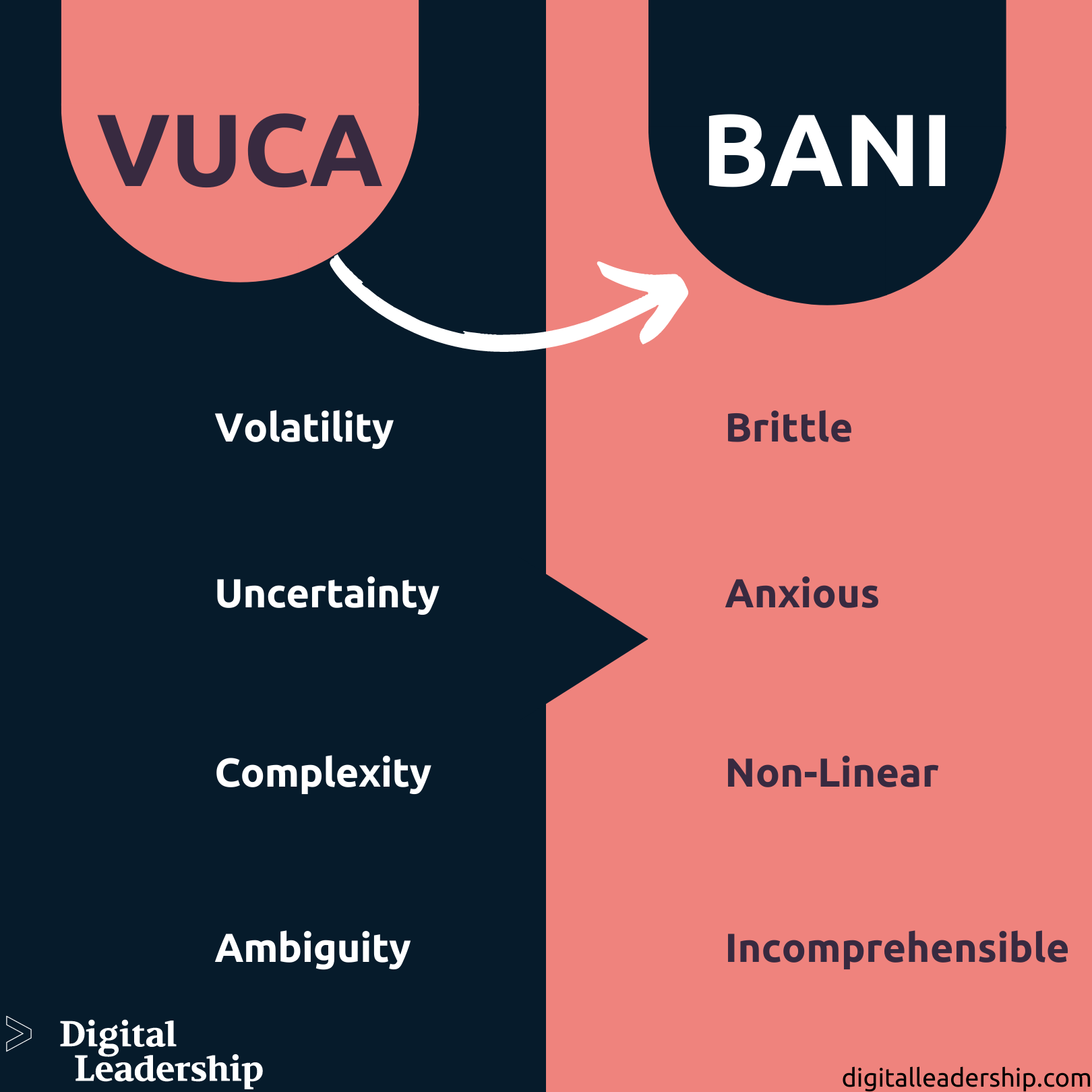VUCA World – Guiding Your Business Towards Success
Published: 17 August, 2023
Transformation

Table of Contents
In an era where the constancy of change outweighs any semblance of certainty, we stand at the precipice of the uncharted VUCA world. Once relegated to the strategic blueprints of organizations, the acronym now weaves a tangible tapestry of our global reality. The VUCA world isn’t a distant hypothesis; it’s our immediate truth—a landscape defined by the seismic tremors of Volatility, where the ground beneath us is prone to sudden shifts. Uncertainty, where the compass of predictability fails; Complexity, where intricacies weave bewildering mazes; and Ambiguity, where even the sharpest minds are left with a perpetual haze.
The predictability of linear trajectories and stable forecasts has yielded the rhythm of perpetual transformation. In this epoch of continuous evolution, enterprises, societies, and individuals are compelled not merely to endure, but to flourish amidst the tempestuous winds of change. Embark with us on an expedition to the core of the VUCA, as we disentangle its trials and unveil its concealed prospects. In the forthcoming pages, we shall explore strategies, narratives, and revelations that guide us forward—a course toward mastery in navigating the intricate realms of the VUCA world.
In our book “How to Create Innovation” – the ultimate guide to business innovation – we delve into the intricate dynamics of the VUCA world, unearthing its profound implications for modern enterprises. You can download it now.
What is VUCA?
VUCA is an acronym that stands for Volatility, Uncertainty, Complexity, and Ambiguity. It originated from the military world but has been widely adopted in various fields, including business, leadership, and strategic planning. Each element of the acronym represents a distinct characteristic of the challenging and rapidly changing environment that organizations and individuals often face:

1- Volatility
In VUCA, “Volatility” symbolizes the perpetual and often unpredictable changes that define our current reality.
Volatility – Definition and Impact:
- Volatility encapsulates the rapidity, scale, and unpredictability of environmental shifts.
- Swift and unforeseen alterations can disrupt existing norms and plans.
- Sources of abrupt changes include economic fluctuations, technological advancements, political shifts, and societal trends.
- Agility and rapid adaptation are essential for individuals and organizations to navigate volatile situations.
Volatility in the Contemporary World:
- Constant and unpredictable transformations define the modern world.
- Swift shifts challenge the ability to foresee consequences.
- The interplay of technological advancements, cultural dynamics, and regulatory shifts contributes to volatility.
- An ever-changing landscape influences products, services, and customer preferences.
- Businesses need to exhibit nimbleness for swift adjustments in response to rapid transformations.
2- Uncertainty
Uncertainty in VUCA signifies the rapid erosion of reliability in using past events, predictions, and historical experiences as a foundation for shaping the future. This erosion leads to the diminishing validity and relevance of these historical sources. Consequently, planning investments, development strategies, and growth trajectories becomes an exceedingly intricate task. Additionally, uncertainty points to the growing lack of clarity about the direction of journeys.
The diminishing capacity to depend on past experiences and data to predict future outcomes characterizes uncertainty in the VUCA paradigm. Shorter product life cycles coupled with the whirlwind pace of changes diminish the effectiveness of conventional market analyses. As a result, charting pathways for growth and making investment decisions becomes intricate due to the unpredictable nature of the environment. Uncertainty challenges entrenched assumptions, necessitating a continuous learning approach and the ability to make prompt decisions.
Implications of Shortened Product Life Cycles:
With product life cycles shrinking at an accelerated rate, the veracity of market analyses is dissipating swiftly in this new world. Consequently, the quantifiable bases for decision-making are rapidly diminishing, intensifying the uncertainty faced by numerous decision-makers. Businesses encounter heightened pressure within the VUCA milieu, particularly if they intend to respond promptly to dynamic changes.
Questions Arising in the VUCA Landscape:
In the VUCA world, queries of fundamental significance emerge, even in areas previously settled:
- How long will our current business model remain effective?
- Which technologies should we embrace to stay competitive?
- How can we distinguish ourselves from global rivals in countries with lower-cost manufacturing?
- What skill sets and job profiles are requisite for our value proposition?
Navigating Disruptive Innovations:
Notably perilous for companies are disruptive innovations, often creeping in surreptitiously. These innovations frequently encounter scepticism and dismissal from established market players initially. However, once they prove successful, the veil of uncertainty lifts, propelling the company forward with newfound momentum.
At Digital Leadership, we offer an Innovation Consulting service that holds immense significance in today’s ever-evolving business landscape, especially in the context of managing the VUCA world. In an environment marked by volatility, uncertainty, complexity, and ambiguity, our consulting service empowers businesses to not only survive but thrive in the VUCA world, ensuring their long-term success and resilience in the face of constant transformation.
3- Complexity
Complexity in VUCA serves as an emblem of the undeniable reality that our world is more intricate than ever before. The intricacies give rise to questions: What are the causes? What are the effects? The very nature of problems and their subsequent impacts has grown convoluted, rendering understanding more challenging. An amalgamation of different levels intertwines, leading to a maze of perplexing interrelationships. Decisions, entwined within an uncontrollable web of reactions and counter-reactions, scarcely find a straightforward path.
Navigating the Web of Complexity:
- The modern landscape ushers in a torrent of changes, driven by new technologies, regulations, globalization, emerging competitors, and evolving customer demands. This transformation has rendered the environment increasingly unmanageable.
- Understanding the cause-and-effect dynamics of these diverse developments has grown progressively daunting. The web of reactions, currents, and interactions adds layers of intricacy.
- Simultaneous changes unfold across numerous levels, creating a tapestry of complexities. Within this labyrinth, managers find their grip on the system slipping, as the dynamics evade easy control.
Unintended Complexities:
- In an attempt to enhance work quality, companies fragment activities into finer tasks. However, this strategy often results in training highly specialized experts and overburdening managers with leadership roles. This added complexity doesn’t always translate to proportional effectiveness, leading to a convoluted organizational structure.
- Businesses seeking to boost sales broaden their service offerings and expand product variety. Unfortunately, each product’s individual planning, development, and marketing contribute to elevated product complexity.
- Endeavours to accelerate work pace and meet tighter deadlines can inadvertently sideline standards and meticulous planning, ultimately elevating the intricacy of operational processes.
Complexity’s Effect on Innovation and Long-Term Success:
- Maneuvering innovation becomes arduous for managers amid a complex environment. Fear of career risks stemming from mistakes can prompt adherence to existing solutions and processes. Consequently, innovation wanes, inhibiting further company development and jeopardizing long-term success.
4- Ambiguity
“Ambiguity” in VUCA embodies a departure from one-size-fits-all approaches and the notion that yesterday’s best practices suffice. Rarely does something present itself as completely unambiguous or precisely determinable. The spectrum of possibilities isn’t confined to just black and white; it’s a canvas painted in vibrant hues. The challenges posed to organizations and leadership in today’s VUCA world are more conflicting and paradoxical than ever before, thoroughly testing personal value systems. The “What?” recedes, allowing the “Why?” and “How?” to take the forefront. In this landscape, decisions call for courage, heightened awareness, and a willingness to embrace mistakes as part of the growth process.
Navigating Ambiguity:
- In the VUCA context, ambiguity pertains to the inherent uncertainty in information. Information open to multiple interpretations carries a substantial risk, often leading to erroneous decisions.
- Managers grapple with the predicament mentioned earlier: apprehensions about detrimental consequences to the company or personal reputation deter them from adopting audacious, strategic actions. As a result, organizational progress stagnates.
The Importance of VUCA
The concept of VUCA holds significant importance in our rapidly evolving world due to its ability to capture and describe the complex and uncertain nature of contemporary environments. Here are some reasons why VUCA is essential:
- Navigating Complexity: VUCA acknowledges the intricate interplay of various factors, systems, and uncertainties that contribute to the complexity of today’s world. Understanding and addressing this complexity is crucial for effective decision-making and problem-solving.
- Strategic Planning: Recognizing the volatility, uncertainty, and ambiguity inherent in the VUCA framework compels organizations to adopt more flexible and adaptable strategies. This is essential to remain competitive and resilient in an environment prone to sudden shifts.
- Adaptation: Embracing the VUCA perspective encourages a proactive approach to change. Businesses and individuals can anticipate disruptions, plan for contingencies, and swiftly adapt to new circumstances.
- Innovation: VUCA underscores the need for continuous innovation and a willingness to explore unconventional solutions. Adapting to the ever-changing landscape requires creative thinking and the courage to challenge traditional norms.
- Risk Management: Understanding the volatility and uncertainty within the VUCA context enables better risk assessment and mitigation strategies. Organizations can identify potential pitfalls and develop strategies to minimize negative impacts.
- Leadership Development: Effective leadership in a VUCA world demands agility, resilience, and the ability to navigate ambiguity. Embracing these qualities enhances leadership capabilities across various sectors.
- Learning and Growth: The VUCA perspective encourages a growth mindset and a commitment to ongoing learning. Individuals and organizations are better equipped to embrace new opportunities and acquire new skills.
- Global Perspective: VUCA highlights the interconnectedness of global systems. Businesses, governments, and individuals must consider the ripple effects of decisions made in one part of the world on other regions.
- Customer-Centricity: As customer needs and preferences rapidly evolve, understanding the VUCA environment is crucial for delivering products and services that remain relevant and valuable.
- Preparedness for the Unknown: VUCA reminds us that the future cannot be predicted completely. It encourages individuals and organizations to develop resilience and preparedness for the unknown.
Managing in a VUCA World
In a world defined by constant change, uncertainty, intricate connections, and blurred lines, the acronym VUCA – representing Volatility, Uncertainty, Complexity, and Ambiguity – encapsulates the essence of our modern reality. Effective management in this environment requires more than adaptation; it demands an innovative approach that thrives in ambiguity and leverages complexity as an opportunity.
VUCA is no longer a mere concept; it’s a paradigm shift. This new perspective acknowledges that success lies in agile responses rather than accurate predictions. This article explores actionable strategies, from fostering adaptability and collaboration to championing innovation, that enable leaders to not just survive but flourish in this dynamic landscape.
Unlocking the power of VUCA transforms challenges into catalysts for growth. By embracing its principles, we can navigate complexity with confidence and carve a path to resilience and triumph in an ever-evolving world.
| Managing in a VUCA World | Advantages | Disadvantages |
|---|---|---|
| 1. Embrace Agility: Adaptability and flexibility allow quick responses to changes. | – Swift adjustments to market shifts. – Ability to seize emerging opportunities. – Enhanced innovation. | – Constant need for recalibration can be exhausting. – Risk of losing focus on long-term goals. |
| 2. Foster Continuous Learning: Encourage a growth mindset and a culture of learning. | – Improved skill sets and knowledge. – Enhanced problem-solving capabilities. – Better preparedness for evolving challenges. | – Balancing operational tasks with learning can be challenging. – Potential resistance to change from established norms. |
| 3. Collaborate and Network: Leverage diverse perspectives for robust decision-making. | – Richer problem-solving through varied viewpoints. – Enhanced creativity and innovation. – Stronger stakeholder engagement. | – Coordination challenges in diverse teams. – Conflict management can be complex. |
| 4. Develop Resilience: Build the capacity to withstand and recover from disruptions. | – Quick rebound from setbacks. – Reduced negative impacts of unexpected events. – Improved stress management. | – Constant exposure to uncertainty can lead to burnout. – Balancing resilience with risk-taking requires finesse. |
| 5. Focus on Scenario Planning: Anticipate potential outcomes and develop strategies. | – Improved preparedness for multiple scenarios. – Better risk assessment and mitigation. | – Resource-intensive process. – Scenarios might not always capture every possibility. |
| 6. Enhance Communication: Keep stakeholders informed and engaged. | – Reduced ambiguity and confusion. – Stronger alignment towards common goals. – Better decision-making with shared insights. | – Maintaining transparency in uncertain situations can be challenging. – Information overload can lead to misinterpretations. |
| 7. Encourage Innovation: Embrace experimentation and creative problem-solving. | – Novel solutions to complex problems. – Competitive edge through unique offerings. – Continuous improvement in processes. | – Not all innovative endeavours yield positive results. – Risk of diverting resources from proven methods. |
VUCA world: Examples from the business world
In a realm defined by volatility, uncertainty, complexity, and ambiguity, real-world examples vividly illustrate the impact of the VUCA world on diverse industries. These instances provide a lens into how businesses navigate and respond to the ever-evolving challenges posed by the dynamic VUCA landscape. Join us as we explore these practical scenarios that unravel the essence of VUCA and its profound influence on the business world.
Example 1: The Automotive Industry’s Tesla Challenge
Car manufacturers have faced a conspicuous instance of overlooking potential, notably in the case of Tesla. For an extended period, Tesla’s promise was dismissed, yet the tides have turned. German automotive leaders and manufacturers find themselves grappling to bridge the gap with their Californian counterparts.
Notably, Porsche, Mercedes-Benz, and others were slated to introduce battery-powered electric vehicles only in 2019. Meanwhile, Tesla, under Elon Musk’s guidance, has surged ahead in aspects encompassing autonomous driving, in-car entertainment, and performance metrics such as range, acceleration, and safety.
To counter Tesla’s ascendancy, major automotive giants have inaugurated specialized innovation arms. Daimler launched CASE, and BMW unveiled D+ACES—dedicated divisions singularly focused on sculpting the trajectory of mobility within their respective companies. This strategic response underscores the pivotal importance of redefining the industry’s future to keep pace with the transformative force of Tesla’s innovations.
Example 2: Turbulence in Telecommunications
Telecommunications, marked by volatile shifts, reflects the essence of VUCA. Rapid technological advancements render devices and services obsolete at an unprecedented pace. As exemplified by Samsung’s experience, the fluctuating smartphone market and evolving technologies like 5G influence profitability. Samsung, a dominant player in memory chips, smartphones, and TVs, faced a significant profit decline due to falling chip prices, illustrating the impact of volatility on market leaders.
Example 3: The Kodak Tragedy in Digital Photography
A poignant illustration of missteps stemming from ambiguity unfolds through the story of the iconic American company, Kodak.
In 1975, Kodak engineer Steve Sasson birthed the world’s inaugural digital camera. However, Kodak’s leadership refrained from embracing this innovation, fearing its potential impact on the core photography film business.
When Sony, a formidable competitor, introduced their digital camera in the early 1980s, Kodak’s leadership commissioned an extensive study to assess the threat posed to their film-centric foundation. Astonishingly, the study predicted a 10-year timeline for digital technology to replace traditional film cameras.
The pivotal juncture exposed Kodak’s executives to ambiguous data; despite projections of decline, the company sustained promising film sales through the mid-1980s. Consequently, the anticipated decade-long shift was allowed to pass without significant preparation for the digital environment.
In the late 1980s, sales plummeted precipitously, compelling Kodak to enact stringent cost-cutting measures. Not until 1991 did Kodak unveil its own digital camera, yet the company couldn’t recapture its former glory. Ultimately, after 120 years of corporate history, Kodak succumbed to bankruptcy, a result of technology that catalyzed its downfall, and developed within its own walls.
Example 4: E-commerce and Retail Transformation
The retail sector mirrors the VUCA world’s disruptive force. The advent of e-commerce giants like Amazon disrupted traditional retail models. Established brick-and-mortar retailers often underestimate the power of online shopping. This miscalculation resulted in the closure of many iconic retail chains. The shift from traditional retail to digital platforms demonstrates the impact of uncertainty on business sustainability.
Example 5: Financial Services and Fintech Disruption
The financial services industry has experienced volatility and uncertainty with the rise of fintech. Traditional banks faced challenges from innovative startups offering streamlined services and enhanced user experiences. Incumbents initially underestimated the potential of these disruptors, allowing fintech companies to gain significant market share. The complexity of adapting to technological changes while maintaining regulatory compliance illustrates the VUCA dynamics at play.
Example 6: Healthcare Innovation and Regulation
The healthcare sector navigates VUCA through rapid technological advancements and evolving regulations. New medical technologies, treatments, and therapies continuously emerge, demanding agile responses from healthcare providers. However, ambiguity about regulatory changes and reimbursement policies poses challenges for decision-makers. Balancing innovation with compliance is essential in this intricate landscape.
Related: Digital Business Strategy Definition, Concepts, and Strategies
VUCA environment described in “CREATING INNOVATION”
Amidst paradigm shifts, both creative innovation and creative destruction emerge prominently. This phenomenon is unmistakably evident in our contemporary reality, where an unprecedented magnitude of transformations across various dimensions unfold within a remarkably condensed timeframe.
Technological Paradigm Shift
In the dynamic VUCA environment, the “Four Waves of Industrial Revolution” model gains importance, as discussed in “CREATING INNOVATION“. This model acts as a guide, illuminating the interplay between technology and VUCA. It outlines industrial evolution, reflecting societal changes. Amid volatility and uncertainty, the model aids navigation, enabling adaptation and innovation. You can download it now.

Designed by: Susanne M.Zaninelli & Stefan F.Dieffenbacher
Implications of Rapid Paradigm Shifts and VUCA Environment:
- Technological progress has led to faster paradigm shifts.
- These shifts have resulted in a more intricate and diverse environment, characterized by volatility, uncertainty, complexity, and ambiguity (VUCA).
- Second, third, and fourth waves of economic development are occurring simultaneously.
- These waves influence different societies, countries, industries, firms, and individuals concurrently.
- The complexity of the modern world is highlighted by the coexistence of these diverse paradigms, sometimes within the same organization.
Exponential Technological Growth and Adaptability:
- Exponential technological capabilities challenge our ability to adapt and evolve.
- Coping with this complexity requires constant adaptation to changing circumstances.
- Individuals, societies, industries, and organizations must navigate the challenges posed by the VUCA environment.
Innovative Tools and Models:
- The need to manage VUCA complexity has led to the development of groundbreaking tools and models.
- These tools and models provide strategic guidance for effectively navigating the complex dynamics of the modern world.
- They offer insights into managing parallel paradigms and addressing the challenges posed by diverse economic waves.
Thriving in a VUCA world
Thriving in our current reality demands business leaders embrace disruption and the potential for being disrupted. This necessitates dynamic adaptability and openness to change.
In the VUCA landscape, the attributes defining effective leadership are undergoing a transformation. While the traditional image of a leader as a decisive figure once prevailed, today, different qualities emerge as pivotal for success in this realm.
Flourishing within a VUCA world entails leaders who:
- Exemplify autonomy and accountability, fostering the same in their teams.
- Cultivate customer relationships and foster meaningful dialogues.
- Build and nurture trust among their teams.
- Empower employees with heightened self-efficacy, fostering brave collaboration in complex situations.
- Embrace the role of crafting a learning organization, viewing it as their core responsibility rather than just a personnel development aspect.
Thriving also involves transcending binary thinking, as the world’s intricacies are rarely confined to simple black-and-white perspectives.

BANI As An Extension Of VUCA?
While VUCA, originating in the 1990s, remains relevant, it faces criticism for its broadness and limited practical application. In contrast, the BANI model emerges as a response to the challenges of our contemporary environment. BANI introduces new dimensions that seek to address the shortcomings of VUCA, providing a more nuanced framework to navigate the complexities of our rapidly changing world.

BANI:
- A recently developed model.
- Responds to modern complexities.
- Introduces Brittle, Anxious, Non-linear, and Incomprehensible dimensions.
- Addresses criticisms directed at VUCA by providing a more comprehensive framework.
- Tailored to the challenges of today’s rapidly evolving and uncertain world.
- It aims to offer a more nuanced understanding of the complexities.
VUCA:
- Coined in the 1990s.
- It continues to hold relevance.
- Faces criticism for being overly broad and lacking actionable strategies.
- Focuses on volatility, uncertainty, complexity, and ambiguity.
- Applicable to dynamic environments, but may need augmentation to address new complexities.
- It may require adaptations to capture evolving uncertainties fully.
For more information about BANI World visit our article BANI World: What is it and Why We Need it? Where we discuss the BANI acronym in detail
Conclusion for business in this world: The world remains VUCA!
In the realm of the VUCA world, characterized by volatility, uncertainty, complexity, and ambiguity, businesses stand at the crossroads of unprecedented challenges and opportunities. As we explored the intricacies of each component, witnessed real-world examples, and grasped insights from “Creating Innovation” it’s evident that thriving in this environment requires adaptive leadership, innovative strategies, and the courage to embrace change. The emergence of BANI as an extension of VUCA further underscores the evolving nature of our world. In this ever-shifting landscape, success lies in our ability to harness innovation, cultivate resilience, and navigate complexities, shaping the VUCA world rather than merely reacting to it.
Frequently Asked Questions
1- Are we living in a VUCA world?
Yes, we are living in a VUCA world. The term “VUCA” describes the volatile, uncertain, complex, and ambiguous nature of the modern global environment, characterized by rapid changes, unpredictability, interconnectedness, and a lack of clear cause-and-effect relationships.
2- What is the purpose of VUCA?
The purpose of the concept of VUCA is to highlight the challenges and uncertainties present in today’s world. It serves as a framework for understanding and navigating complex and rapidly changing situations, encouraging individuals, organizations, and societies to develop strategies that promote adaptability, resilience, and innovative thinking.
3- What is the most important thing in a VUCA world?
In a VUCA world, adaptability is often considered one of the most important attributes. Being able to adjust to unexpected changes, learn quickly, and find creative solutions is crucial for individuals and organizations to thrive.
4- What is the key to success in a VUCA world?
The key to success in a VUCA world is a combination of adaptability, continuous learning, agility, and the ability to anticipate and respond to change. Developing a mindset that embraces change, values collaboration, and seeks out new opportunities is essential.
5- How does VUCA influence our mindset?
VUCA challenges traditional linear thinking and encourages a more flexible and open mindset. It prompts individuals to be comfortable with uncertainty, to think critically, to seek diverse perspectives, and to be proactive in learning and problem-solving.
6- How do you make decisions in a VUCA world?
In a VUCA world, decision-making requires a balance of analysis and intuition. It’s important to gather as much information as possible, consider various scenarios, and be willing to adapt decisions as circumstances change. Embracing experimentation and learning from failures also play a significant role in decision-making.

































 Book How to Create Innovation
Book How to Create Innovation